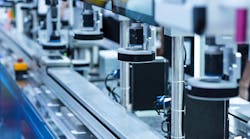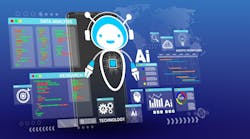What’s Now, What’s Next for Machine Vision?
We are living in an age of turbocharged commerce and next-level consumer expectations.
Customers will not hesitate to return a product that has a scratch or a food item past its expiration date. Defects can hurt a brand or retailer’s credibility in an era when maintaining consumer trust is critical.
One way companies are addressing this challenge is through a growing reliance on enterprise computer vision and machine vision solutions. One report predicts that the global computer vision market will be worth $17.4 billion by 2023, up from $11.9 billion in 2018. Furthermore, a 2018 Deloitte survey of 1,100 U.S. executives found that 57% of those businesses had already adopted machine vision.
This is not surprising, as many organizations have embraced artificial intelligence (AI) and automation to speed up supply chains, increase inventory and order accuracy, and improve quality control.
As manufacturers and logistics providers race to increase throughput, a new generation of machine vision systems is simplifying expedited goods inspection without compromising accuracy, with the promise of bolstering fulfillment capabilities in demanding and labor-constrained situations.
Redeeming Machine Vision
Computer vision enhances the power of human operations to see, understand and react to a broad set of stimuli in real time. However, machine vision is the targeted application of vision technology in mechanical processes, using image analysis to identify specific pre-programmed features, compare the current image to an expected result and then execute a function based on that result.
In its most basic functionality, machine vision is leveraged on production lines to determine whether a part or product is up to standards, using information extracted from digital images to compare against a set of rules. It can then automatically remove items from the production line that do not pass a “yes or no” test.
For example, in a production or manufacturing environment, machine vision cameras can be used to detect whether a soda bottle’s contents are millimeters short of its fill line, thus impacting total volume, or if a screw isn’t threaded properly, potentially deteriorating its viability or the integrity of the product it will be used to hold together. In a warehousing environment, these same cameras can be used to detect a tiny ding on a returned electronic device, which could indicate it was dropped at some point and may have internal component damage. Or they could be used to confirm that labels are properly placed on boxes before being transferred to pallets.
Considering the nuanced variations that might exist from one part or product to the next, and the small scale of the defects that manufacturers and warehouse operators must look out for, it makes sense that machine vision systems are widely used for performing inspections along the line. They can capture and analyze images much faster than humans alone. And with enhanced resolution—in some cases well beyond the human’s visual spectrum—powerful machine vision cameras can see what is too small or even invisible to the human eye.
They also have a better image retention mechanism, which helps when monitoring for defect patterns and pursuing resolutions.
For decades, machine vision used rules-based inspection programs that required specialized talents typically outside the average software engineer’s skillset. Customizing and maintaining these machine vision programs required costly investments and the work of expert programmers. Because of this complexity, some factory managers and engineers had written off machine vision altogether, considering it too expensive and challenging to implement—despite the rising importance of quality control. In many cases, only the largest organizations had easy access to machine vision in their industrial operations.
But things have changed. Within the past few years, a combination of factors has made machine vision more accessible and useable across different types of workflows and companies. Originally associated with the electronics and automotive industries, the increased accessibility of machine vision is driving an expansion into new sectors, including surveillance, medical and pharmaceuticals, food and beverage, and robotics—all of which demand a certain level of precision to execute.
For example, pharmaceutical manufacturers—like many others with strict regulatory oversight—must execute very specific process control measures to ensure every pill produced meets quality and purity standards. If the color, size, shape or markings of either the pill or packaging does not match the specifications programmed into a machine vision camera, the operator can be notified of a potential noncompliance issue and the products removed from the line for further testing and verification.
Deep-Learning Possibilities
The industrial automation market is rapidly evolving and increasingly dynamic. The evolution of AI technology has become so quick that much of what defined machine vision only three years ago no longer applies. Thanks to deep learning, it’s become easier for smaller organizations to set up, deploy and run machine vision systems without specialized staff.
What is deep learning? Within AI, there is a subset of algorithms known as machine learning algorithms. Within that subset, there is a family of machine learning algorithms known as deep learning. Deep learning involves developing software that can learn like humans, using data and predictive analytics to understand patterns and make decisions.
As deep learning matures, it can be deployed more often, with the expectation that it takes over even more of the manufacturing applications traditionally done using rule-based programming. If shown enough examples, the computer can learn to reliably indicate on its own the difference between acceptable and unacceptable parts and products coming down the production line.
Though this represents a huge step forward in accessibility, AI technology can still make mistakes. However, like a human, it can get smarter as it matures. The more it learns, the more accurate and reliable its performance becomes. But, for these algorithms to work, enhanced computer processing power is required.
Thanks to smaller chips that hold even more power, today’s AI systems are small enough to operate in even the most constrained spaces. This is another key factor in the growing accessibility of machine vision.
Achieving an Automated Future
Operational orchestration is the goal for many businesses, requiring the coordination of real-time intelligence technologies, inventories, and human labor to drive competitive advantage. This new era of machine vision makes it easier for employees to oversee and operate automated systems without requiring a higher level of education in computer science.
Machine vision can now be a part of more steps in the manufacturing process, enhancing data collection to improve track and trace, speeding up fulfillment picking and packing, and guiding employees or robotics with the integration of the Internet of Things (IoT). High-performance scanners and cameras can improve AI and IoT functionality within the warehouse environment.
While machine vision systems still require advanced camera technology, the devices involved are easier to manage with software that can seamlessly integrate into the overall factory operations. For example, machine vision leverages much of the same core imaging technology used within fixed industrial scanners in these same environments.
This convergence of advanced technologies into a single holistic solution offers a step forward in the achievement of industrial automation.
Donato Montanari is vice president and general manager of Machine Vision, Zebra Technologies.




